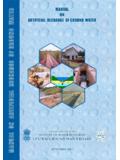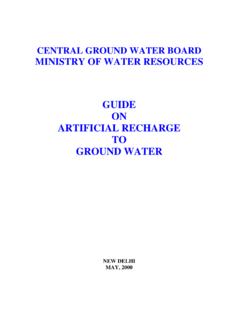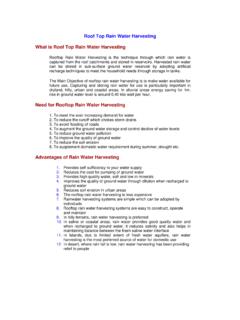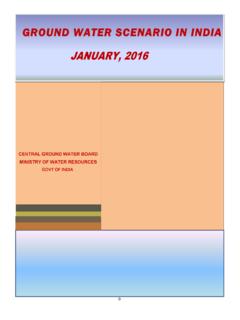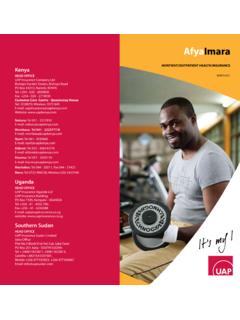Transcription of DEWAS DISTRICT - Central Ground Water Board
1 DEWAS DISTRICT . MADHYA PRADESH. Ministry of Water Resources Central Ground Water Board North Central Region BHOPAL. 2013. DISTRICT PROFILE - DEWAS DISTRICT . ITEMS Statistics 1. GENERAL INFORMATION. i) Geographical area (sq. km) ii) Administrative Divisions (As on 2011 ). Number of Tehsil 6. Number of Blocks 6. Number of Panchayats 497. Number of Villages 1127. iii)Population (Census 2011) 289438. iv)Normal Rainfall (mm) 1083. 2. GEOMORPHOLOGY. i) Major Physiographic Units Plateau 2. Kali Sindh Basin 3. Vindhyan Range 4. Middle Narmada Valley Kshipra sub-basin Kali Sindh sub-basin ii) Major Drainage Chotti Kali Sindh sub-basin Kanhar sub-basin Khari sub-basin Datuni sub-basin Jamner sub-basin Narmada direct catchment 3. LAND USE (ha). i) Forest area: 206600. ii) Net area sown: 388400.
2 Iii) Cultivable area: 624500. 4. MAJOR SOIL TYPES Black cotton , Sandy loam, Clayey loam,, Murram 5. AREA UNDER PRINCIPAL CROPS (2009) Wheat, Soyabean, Groundnut, Cotton, etc 6. IRRIGATION BY DIFFERENT SOURCES No of Area (ha). Structures Dug wells 36531 65900. Tube wells/Bore wells 23119 93100. Tanks/Ponds 169 4760. Canals 15 6760. Other Sources - 11044. Net Irrigated Area - 193640. 7. NUMBER OF Ground Water . MONITORING WELLS OF CGWB (As on ). No. of Dug Wells 16. No. of Piezometers 11. 8 PREDOMINANT GEOLOGICAL Deccan trap lava flows FORMATIONS. 9 HYDROGEOLOGY. Major Water Bearing Formation Weathered/Fractured (Pre-monsoon depth to Water level during Basalt 2012) mbgl (Post-monsoon depth to Water level during mbgl 2012). Long Term Water level trend in 10 years (2003- to m (Rise).
3 2012) in m/yr to m (Fall). 10. Ground Water EXPLORATION BY. CGWB (As on ). No of wells drilled (EW,OW,PZ,SH, Total) EW-32, PZ-12, Total -44. Depth Range (m) 150m 200m Discharge (litres per second) 1 Storativity (S) - Transmissivity (m2 /day) 5-40 m / day 11. Ground Water QUALITY. Presence of Chemical constituents more than permissible limit (eg EC, F, As,Fe) Fluoride Type of Water Alkaline earth- bicarbonate 12 DYNAMIC Ground Water RESOURCES. ( ) in ham Net annual Ground Water availability 79141. Gross Annual Ground Water Draft for all uses 63383. Projected Demand for Domestic and Industrial 3449. Uses upto 2033. Stage of Ground Water Development 80 %. 13 EFFORTS OF ARTIFICIAL RECHARGE &. RAINWATER HARVESTING. Projects completed by CGWB (No.) 4. Projects under technical guidance of CGWB 5.
4 (Numbers). 14 Ground Water Control And Regulation Number of OE Blocks 02 ( DEWAS & Sonkutch). Number of Semi-Critical Blocks 01 (Khategaon). Number of Notified Blocks Nil Introduction The DEWAS DISTRICT lies in the Central part of the state and covers an area of sq km. It lies between North latitude 22o17'00 & 23o20'00 and east longitude 75o50'00 & 77o10'00 , falling in Survey of India topo sheet Nos 46M, 46N, 55A, 55B & 55F. The Tropic of Cancer passes through the DISTRICT near Nemawar village south of Khategaon town . DEWAS lies north-east of Indore, south-east of Ujjain and southwest of Shajapur. The city is located on the level plains of the Malwa plateau; to the south, the land rises gently to the Vindhya Range, which is the source of the Chambal and Kali Sindh rivers.
5 The DISTRICT is divided into six Tehsils and six development Blocks. There are 1061 villages and 11 towns in the DISTRICT . Table: Administrative Divisions, DISTRICT DEWAS , S No Block Area (Sq Km) No of towns 1. Bagli 3. 2. DEWAS 1. 3. Kannod 4. 4. Khategaon 1. 5. Sonkatch 2. 6. Tonk khurd - SOIL : Almost three fourths of the area in the DISTRICT is covered by black cotton soils, which is occupied by Deccan Basalts. The southern part has red- yellow mixed soils derived from sandstone, shale, gneiss. The alluvial soils are found along the river courses. The higher elevations the hilly regions have a cover of murum, which comprises small rounded pieces of weathered trap. The Vindhyans and Bijawars have a thin cover of sandy loams. The soils in granitic area are clayey. The schist has a thin capping of loam with lot of quartz grains.
6 The alluvium is derived from hill slopes by numerous streams and watercourses. DRAINAGE: The DISTRICT falls under two major drainage basins - the Ganga in the north and the Narmada in the south. The rivers are rivers of antiquity. They have broad, flat, shallow valleys with low imperceptible gradients, because their channels have reached the base level of erosion. Vertical erosion has ceased and lateral erosion is taking place. IRRIGATION: Ground Water is the main source of irrigation and accounts for 82% of the irrigation. Other sources and ponds contribute a small amount . 18%. Only 50% of the net sown area is irrigated. Thus 50% sown area is rain- fed. CROPPING PATTERN : The principal crop grown in the DISTRICT is soyabean, wheat, Ground -nut, cotton, etc. WORK CARRIED OUT BY CGWB.
7 Systematic Hydrogeological surveys carried out in parts of DEWAS DISTRICT between 1970 & 1988 and reappraisal hydrogeological surveys in 1993-94. World Bank assisted Hydrology Project- I: Eleven shallow and deep piezometers have been drilled by the Central Ground Water Board and 26. piezometers have been drilled by the State Ground Water Department in the DISTRICT , for Water level and quality monitoring. Ground Water exploration program of the Central Ground Water Board , 17 exploratory wells have been drilled in the DISTRICT . Artificial recharge studies have been carried out in Londri flood plain area, Chhoti Kali Sindh watershed, Nagda watershed and DEWAS Bank Note Press areas of the DISTRICT . Roof top rainwater harvesting has been done at Government Hospital, DEWAS , Tribal Hostel, Sonkutch and Primary School, Tappa village.
8 For Promoting roof top rain Water harvesting 1000 filters, each costing Rs. were distributed among the people of DEWAS City. Central sector Scheme: One Demonstrative Project DEWAS Watershed in collaboration with Public Health Engineering Department, DEWAS , Madhya Pradesh Government, is taken up in the year 2006 in The Upper Reaches of Choti Kali Sindh River , under this project Stop Dam 11, Gabion-10, Recharge Shaft 01, Percolation tank 01, Sub-Surface Dyke-01. & Rooftop Rain Water harvesting 02 is being constructed and impact analysis is to be done. Rainfall & Climate: The average annual rainfall of DEWAS DISTRICT is 1083 mm, based on average of 3 stations. Rainfall increases from west to east and is lowest in the southwestern portion. About 90 % of the rainfall takes place from June to September, only 5 - 8% takes place in the winter months and only about 2%.
9 In summer. It is only during the monsoon that surplus Water for deep percolation is available in the DISTRICT . The normal rainfall follows a normal distribution during the year. The climate of DEWAS DISTRICT is semi- tropical, characterised by hot summer and well distributed rainfall during the south west monsoon season. January is the coldest month with the temperature falling as low as 2o - 3oC. The period from March to first week of June is the summer season. May is the hottest month when the temperature may go upto 45oC. Geomorphology & Soil Types : The DISTRICT can be divided into four broad physiographic divisions (1) DEWAS plateau (2) Kali Sindh Basin (3) Vindhyan Range (4) Middle Narmada valley. The DEWAS plateau extends over the north-western part of Sonkatch block and western part of DEWAS block.
10 This division is a part of the Malwa plateau with higher elevation in the north and plain land topography in the south. Chhoti Kali Sind and Kshipra rivers drain this region. DEWAS town is situated on this plateau. The maximum elevation is 700 m amsl, north of DEWAS town . A conical hill housing the shrine of Goddess Chamunda is located in DEWAS town . The Kali Sindh Basin is situated in the northeastern part of the DISTRICT in a north-south column covering Tonk Khurd and part of Sonkautch blocks. The Kali Sindh river flowing in the centre forms its drainage system. This is the most fertile tract of the DISTRICT . The Vindhyan Hill Range passes through the middle of the DISTRICT in an east-west direction forming a narrow strip. Kshipra and Kali Sindh rivers originate from north of this range, while the tributaries of the Narmada originate from south of it.


